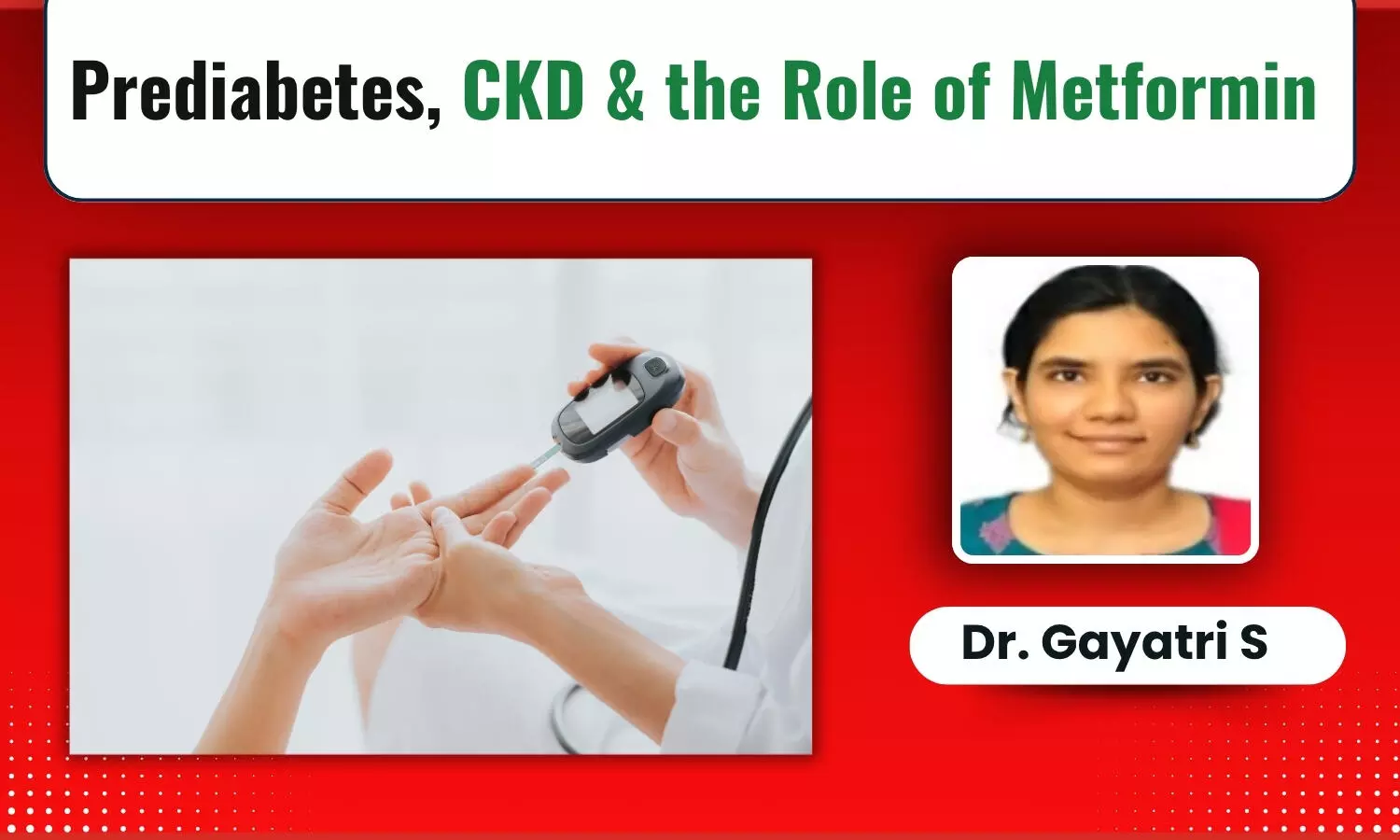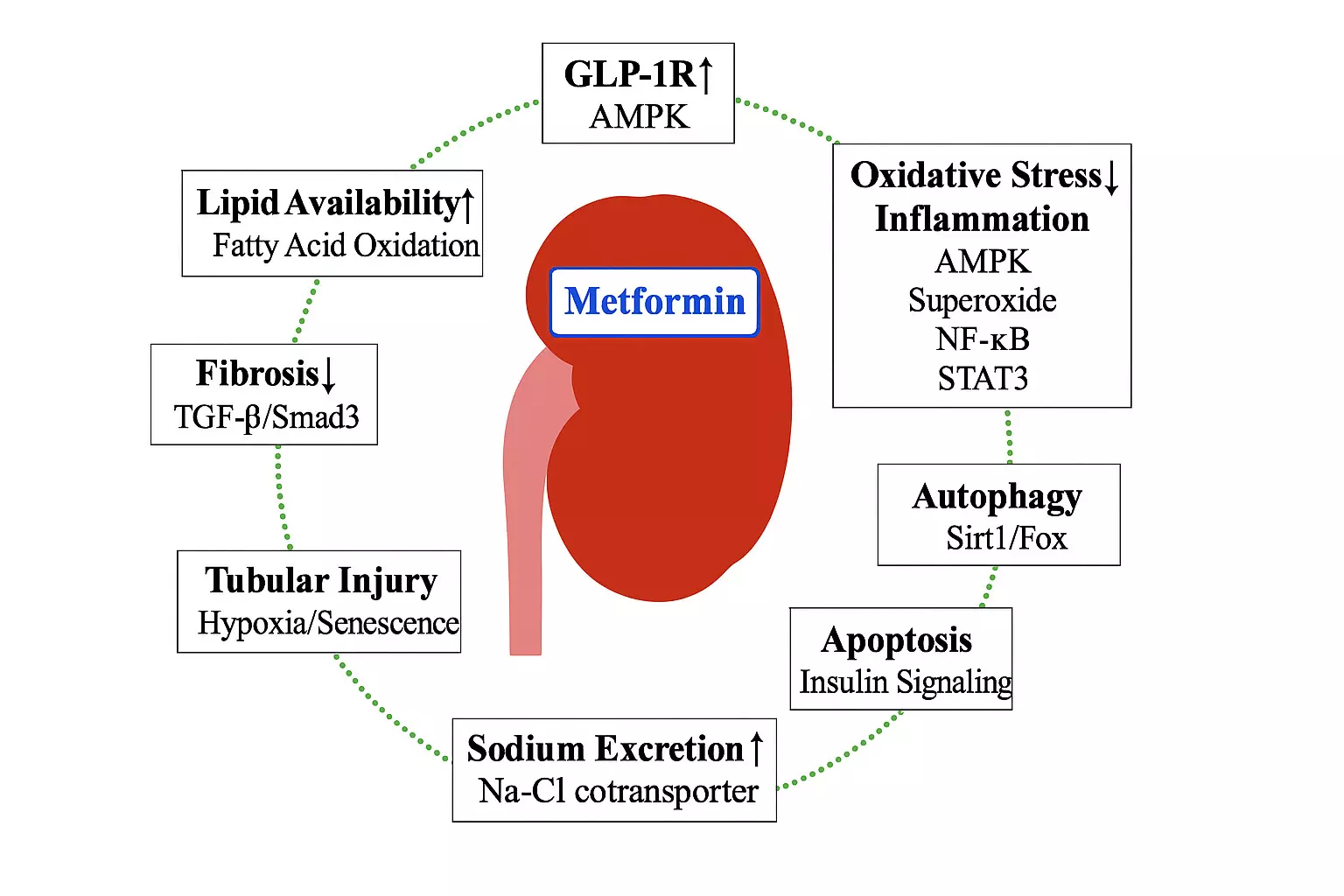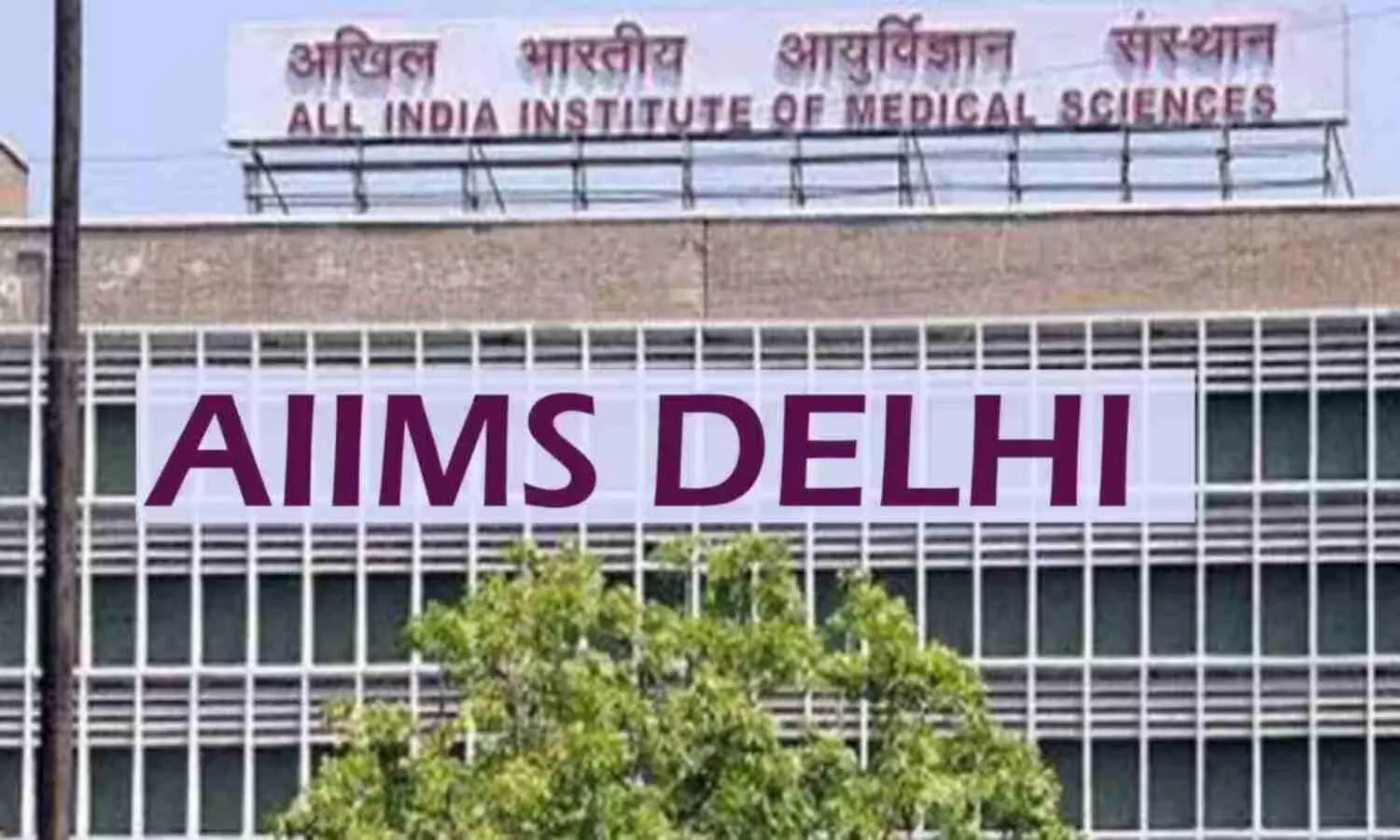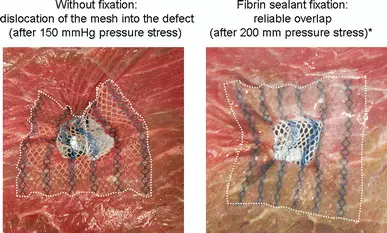
Prediabetes and CKD: A Growing Double Burden
The rising prevalence of prediabetes and chronic kidney disease (CKD) in India reflects an often-overlooked interaction in the early phases of this metabolic disease. Analysis of 19,66,449 adult HbA1c samples from India found 22.25% to be prediabetic, (1) while pooled data from Indian community-based studies reported a CKD prevalence of 13.24%. (2) On a global scale, the IDF (2025) reported 634.8 million adults (12%) with impaired glucose tolerance (IGT), with South-East Asia showing the highest burden at 13.8%. (3) Beyond overt diabetes, prediabetes and insulin resistance are increasingly recognized as contributors to early renal dysfunction. Low-grade inflammation and neurohormonal activation, hallmarks of insulin resistance, are implicated in glomerular hyperfiltration, albuminuria, and early GFR decline. (4)
Prediabetes & Correlation with CKD Onset: Evidence from the Latest 2025 CURE-CKD Study
The CURE-CKD Registry cohort study (2025) analyzed 281,933 adults with prediabetes, defined per ADA criteria. Over a median 2.5-year follow-up, 3.6% (n=10,104) developed CKD, with a standardized incidence of 10.9 cases per 1000 person-years. Incidence increased with age and was higher in individuals with hypertension or ASCVD (11.9 vs. 9.4 per 1000 person-years).
Mechanistic findings suggest that glomerular hyperfiltration and high-normal albuminuria, early renal abnormalities, are more common in prediabetes. These alterations, likely driven by low-grade inflammation and hyperfiltration-induced stress, may promote CKD progression even before diabetes onset. (5)
Potential Role of Metformin in Early Renal Risk: Renal Protection Beyond Glycemic Control
In a nationwide Scottish cohort of 4,278 adults with type 2 diabetes and newly diagnosed stage 4 CKD, stopping metformin within 6 months was associated with a 26% higher risk of all-cause mortality [HR 1.26, 95% CI: 1.10–1.44]. (6) A recently published 2025 cohort study analyzed 10,330 matched patients with eGFR ≥60 mL/min/1.73 m² found that metformin reduced the risk of ESRD by 35% and preserved renal function. (7)
The figure below presents key mechanisms by which metformin confers renoprotective effects in diabetic kidney disease.
Figure: Key pathways of metformin’s renoprotective action in DKD, including AMPK activation and suppression of fibrosis, inflammation, and oxidative stress. Adapted from Kawanami D et al., Int J Mol Sci. 2020;21(12):4239. doi:10.3390/ijms21124239
Metformin Use in CKD: What the Guidelines Say
|
Guideline
|
Recommendations
|
|
Asian Pacific Society of Nephrology (2025)
|
Recommends metformin as first-line therapy in diabetic kidney disease with eGFR ≥30 mL/min/1.73 m². Dose adjustment is advised for eGFR 30–44, and discontinuation below 30. Initiation is discouraged if eGFR is <45. (8)
|
|
ADA (2025)
|
Advised using metformin if eGFR is ≥30 mL/min/1.73 m², with 50% dose reduction for eGFR 30–44, and discontinuation when eGFR falls below 30. (9)
|
|
KDIGO (2024)
|
Recommends continuing metformin in CKD patients with eGFR ≥30 mL/min/1.73 m², using lower doses if eGFR is 30–44, with individualized risk-benefit assessment. (10)
|
|
ADA-KDIGO (2022)
|
Consensus recommends metformin as first-line therapy in type 2 diabetes with CKD and eGFR ≥30 mL/min/1.73 m². A reduced dose (500–1000 mg daily) is advised for eGFR 30–44, and it should be discontinued if eGFR falls below 30 or during acute illness. (11)
|
Key Considerations for Practice
Since metformin is now approved for use in patients with eGFR as low as 30 mL/min/1.73 m², regular eGFR monitoring is essential to guide dosing. UACR testing aids in detecting early glomerular injury and risk stratification.
Though rare, lactic acidosis risk warrants caution during acute illness or in elderly patients with declining renal reserve. To avoid therapeutic inertia, early renal risk, such as hyperfiltration or high-normal albuminuria, should prompt timely intervention in prediabetic patients. (8,9,10,11)
Take Home Message
- A significant portion of Indian adults show early metabolic risk, with widespread prediabetes and rising chronic kidney disease prevalence.
- In the CURE-CKD study, over 10,000 prediabetic individuals progressed to CKD within just 2.5 years.
- Metformin may offer renal protection in prediabetes through AMPK activation, anti-inflammatory, and anti-fibrotic pathways.
- Guidelines from APSN, KDIGO, ADA, and the ADA-KDIGO consensus recommend the consideration of metformin in CKD patients with an eGFR of≥30 mL/min/1.73 m².
Reference:
1. Vora, Hardeep, and Preet Kaur. “Prediabetes and diabetes in India: An HbA1c based epidemiology study.” Diabetes research and clinical practice vol. 217 (2024): 111889. doi:10.1016/j.diabres.2024.111889
2. Talukdar, Rounik et al. “Chronic Kidney Disease Prevalence in India: A Systematic Review and Meta-Analysis From Community-Based Representative Evidence Between 2011 to 2023.” Nephrology (Carlton, Vic.) vol. 30,1 (2025): e14420. doi:10.1111/nep.14420
3. International Diabetes Federation. IDF Diabetes Atlas. 11th ed., 2025, www.diabetesatlas.org. Accessed on 3rd June 2025
4. Rico-Fontalvo, Jorge, et al. “Prediabetes and CKD: Does a Causal Relationship Exist.” Nefrología, vol. 44, no. 5, Sept.–Oct. 2024, pp. 628–638. Elsevier, https://doi.org/10.1016/j.nefro.2024.06.008.
5. Alicic, Radica Z et al. “Incidence of chronic kidney disease among adults with prediabetes in the CURE-CKD registry, 2013-2020.” Diabetes, obesity & metabolism vol. 27,6 (2025): 3536-3541. doi:10.1111/dom.16365
6. Lambourg, Emilie J et al. “Stopping Versus Continuing Metformin in Patients With Advanced CKD: A Nationwide Scottish Target Trial Emulation Study.” American journal of kidney diseases : the official journal of the National Kidney Foundation vol. 85,2 (2025): 196-204.e1. doi:10.1053/j.ajkd.2024.08.012
7. Lin, Yu-Ling et al. “Role of Metformin in Preventing New-Onset Chronic Kidney Disease in Patients with Type 2 Diabetes Mellitus.” Pharmaceuticals (Basel, Switzerland) vol. 18,1 95. 14 Jan. 2025, doi:10.3390/ph18010095
8. Liew, Adrian et al. “Executive Summary of the Asian Pacific Society of Nephrology Clinical Practice Guideline on Diabetic Kidney Disease-2025 Update.” Nephrology (Carlton, Vic.) vol. 30,5 (2025): e70031. doi:10.1111/nep.70031
9. American Diabetes Association Professional Practice Committee; 11. Chronic Kidney Disease and Risk Management: Standards of Care in Diabetes—2025. Diabetes Care 1 January 2025; 48 (Supplement_1): S239–S251. https://doi.org/10.2337/dc25-S011
10. Kidney Disease: Improving Global Outcomes (KDIGO) CKD Work Group. “KDIGO 2024 Clinical Practice Guideline for the Evaluation and Management of Chronic Kidney Disease.” Kidney international vol. 105,4S (2024): S117-S314. doi:10.1016/j.kint.2023.10.018
11. de Boer, Ian H et al. “Diabetes Management in Chronic Kidney Disease: A Consensus Report by the American Diabetes Association (ADA) and Kidney Disease: Improving Global Outcomes (KDIGO).” Diabetes care vol. 45,12 (2022): 3075-3090. doi:10.2337/dci22-0027
Abbreviations: CKD – Chronic Kidney Disease, IGT – Impaired Glucose Tolerance, ADA – American Diabetes Association, IDF – International Diabetes Federation, ASCVD – Atherosclerotic Cardiovascular Disease, CURE-CKD – Center for Kidney Disease Research, Education, and Hope Chronic Kidney Disease Registry, eGFR – Estimated Glomerular Filtration Rate, ESRD – End-Stage Renal Disease, AMPK – AMP-Activated Protein Kinase, TGF-β1 – Transforming Growth Factor Beta 1, KDIGO – Kidney Disease: Improving Global Outcomes, APSN – Asian Pacific Society of Nephrology, UACR – Urine Albumin-to-Creatinine Ratio, AMPK – AMP-activated protein kinase, GLP-1R – Glucagon-like peptide-1 receptor, TGF-β – Transforming growth factor beta, Smad3 – Mothers against decapentaplegic homolog 3 (a downstream signaling protein in TGF-β pathway), NF-κB – Nuclear factor kappa-light-chain-enhancer of activated B cells, STAT3 – Signal transducer and activator of transcription 3, Sirt1 – Sirtuin 1 (a NAD⁺-dependent deacetylase involved in autophagy and stress resistance), FoxO1 – Forkhead box protein O1 (a transcription factor involved in oxidative stress resistance and autophagy), Na-Cl cotransporter – Sodium-chloride symporter, a renal tubular transporter involved in sodium reabsorption











